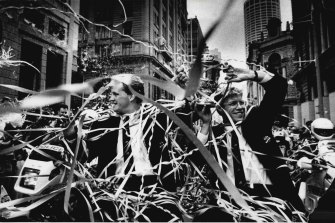From the Archives 1991 Wallabies win their place in rugbys history
First published in The Age on November 4, 1991
Wallabies win their place in rugby’s history
There’s a spirit in the Wallabies
Mere words cannot describe,
It’s as if they had descended
From some legendary tribe.
There’s a kinship, a tradition,
As in days so long since past,
Of crusades, of knights in armour,
Aid of men before the mast.
London, Sunday - Before and after Australia’s 12-6 World Cup final victory over England yesterday, a four-verse poem, called ‘The Spirit of the Wallabies’, was recited by Australian assistant coach Bob Templeton to the players in the Twickenham dressing room.

The Wallabies are swamped in a ticker tape parade in Sydney to honour their World Cup win.Credit:Craig Golding
When Templeton was beckoned to his feet after the victory to read out the poem â€" written some years ago by Sydney coach Peter Fenton â€" several of the players admitted being “misty-eyedâ€. They knew that, at last, they were crusaders, knights, supermen. They were now a legendary tribe. They were world champions.
The name of these 15 warriors â€"Roebuck, Egerton, Little, Horan, Campese, Lynagh, Farr-Jones, Coker, Ofahengaue, Poidevin, McCall, Eales, McKenzie, Kearns and Daly â€" will never be forgotten, simply because they had provided Australian rugby with its greatest moment.
And Australian sport has had few more emotional moments in recent times than when Wallaby captain Nick Farr-Jones raised the William Webb Ellis trophy above his head to show that, at last, Australia was the best in the world in a sport only of minor standing at home behind rugby league and Australian football.
The occasion aside, it was also the special spirit of this Australian team, easily the most popular outfit in the tournament, that made its World Cup conquest so memorable. Australian rugby has prided itself for so long on its adherence to the running game, and everything else that is pleasing to the eye.
Yet it was in the area of defence â€"where the Australians have been so vulnerable over the years â€" that they ensured their success. Their running game got them into the World Cup final; their defensive game put their name into the history books.
To the surprise of everyone, England constantly attacked by throwing the ball wide, as did the All Blacks the week before in the semi-final. But both failed because of the overwhelming steel in the Australian defence. The Wallabies were the ultimate guards, showing as much defiance as an antagonised Twickenham gatekeeper in refusing to let anyone through.
The Australian players were today still boasting about the fact that only three tries were scored against them in this tournament. In 480 minutes of football, tries were scored against them in the 28th, 68th and 312th minute. In the same period, Australia scored 17 tiles.
On so many occasions yesterday England looked to be at the point of breaking through after receiving so much good ball and repeatedly extending play.
But every time England looked dangerous, an extraordinary tackle would come from an Australian player to ruin its momentum. Several tackles stand out, particularly second rower John Eales’ magnificent cover work to emerge from nowhere and plough down Andrew in the second half. Andrew had looked to be on his way to score the try that might have given England a whiff of victory. Instead, the Englishman’s nose was burrowed into the turf through an exceptional tackle after Eales gave him at least a 10-metre start.
Then there was the faultless defence from the other forwards, and the impregnable wall that centres Tim Horan and Jason Little built that eventually had England struggling for ideas. This resistance was so overpowering that Australia was able to get away with scraps of possession, and needed only one soft try to keep England at bay.
Yet it all revolved around the Australians properly taking their chances. The Wallabies only rarely came near the England line, but when they did they took advantage of the situation. The Wallabies’ only try, scored in the 26th minute, could not have come at a better time, particularly with England looking dangerous.
Great solo work by Horan saved Australia. He took a bomb near his own quarter line, before running through the defence, sprinting for 60 metres then kicking the ball into touch just short of the corner flag. From that came a great two-handed take in the middle of the line-out from Willie Ofahengaue.
Front rowers Ewen McKenzie and Tony Daly swept around Ofahengaue, starting a whirlwind of a rolling maul, which ended with the two props diving over the line together, both holding the ball. Confusion over who scored continued for hours until the Australian management revealed that Daly thought he had scored, even if it was very much a case of two points for Daly and two for McKenzie.
It did not matter. The try had the desired effect of giving Australia big enough buffer zone to keep England at bay for the next 54 minutes.
After that, the only time the Australian defence slackened was during the celebrations, when the Wallabies let through anyone who wanted to offer congratulations to the world champions. \
Gold jerseys everywhere: Wallabies Tim Horan, left, Simon Poidevin, centre, and David Cam pose combine to beat England’s Mike Teague in moving the ball from loose play in Satuiday’s World Cup final at Twickenham.
0 Response to "From the Archives 1991 Wallabies win their place in rugbys history"
Post a Comment